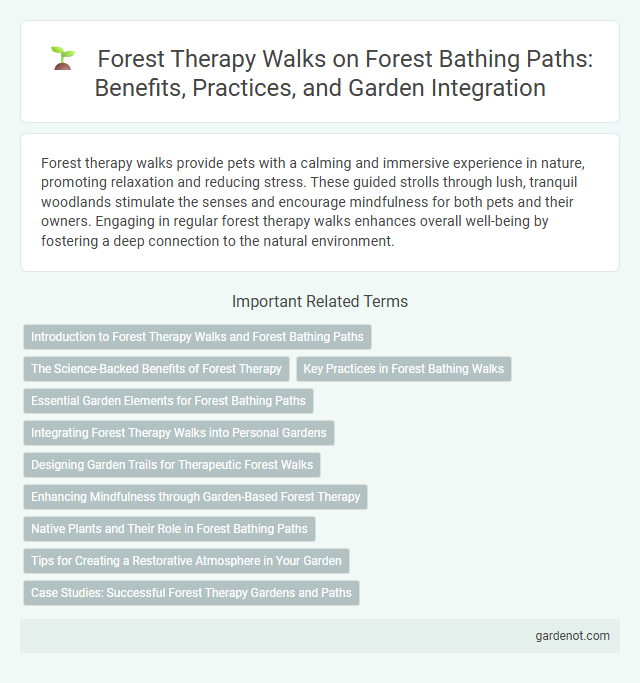Forest therapy walks provide pets with a calming and immersive experience in nature, promoting relaxation and reducing stress. These guided strolls through lush, tranquil woodlands stimulate the senses and encourage mindfulness for both pets and their owners. Engaging in regular forest therapy walks enhances overall well-being by fostering a deep connection to the natural environment.
Introduction to Forest Therapy Walks and Forest Bathing Paths
Forest therapy walks, also known as forest bathing paths, offer immersive nature experiences designed to enhance mental and physical well-being through mindful exploration of natural environments. These paths encourage slow, intentional walking combined with sensory engagement to reduce stress, improve mood, and boost immune function. Research shows that spending time on forest bathing paths can lower cortisol levels and promote relaxation, making them effective tools for holistic health.
The Science-Backed Benefits of Forest Therapy
Forest therapy walks enhance mental health by reducing cortisol levels and lowering blood pressure, according to multiple scientific studies. Exposure to phytoncides, natural compounds emitted by trees, boosts immune function and increases natural killer cell activity. Practicing forest bathing also improves mood and cognitive function by promoting parasympathetic nervous system activation and reducing stress-related hormones.
Key Practices in Forest Bathing Walks
Forest therapy walks emphasize mindful immersion in nature through slow, deliberate walking, attentive breathing, and sensory engagement with the forest environment. Key practices include focusing on natural sounds, observing diverse plant species, and grounding exercises such as barefoot walking to enhance connection with the earth. These techniques promote stress reduction, improved mood, and a deeper sense of well-being.
Essential Garden Elements for Forest Bathing Paths
Forest bathing paths incorporate essential garden elements such as native plant species, water features, and natural textures to enhance sensory engagement and promote relaxation. Integrating diverse flora supports local biodiversity and provides seasonal variations in color and scent, enriching the therapeutic experience. Soft trails lined with moss, shaded by mature trees, and complemented by gentle sounds of flowing water foster mindfulness and reduce stress during forest therapy walks.
Integrating Forest Therapy Walks into Personal Gardens
Integrating forest therapy walks into personal gardens enhances mental well-being by creating immersive natural environments that promote relaxation and mindfulness. Incorporating native trees, sensory plants, and meandering paths stimulates all five senses, fostering a healing atmosphere rooted in biophilic design. This personalized forest bathing space encourages regular nature connection, reducing stress and improving overall health.
Designing Garden Trails for Therapeutic Forest Walks
Designing garden trails for therapeutic forest walks emphasizes creating immersive sensory experiences through varied plant species, natural textures, and soothing sounds that promote relaxation and mental restoration. Incorporating gentle slopes, ample seating areas, and clear wayfinding enhances accessibility and encourages mindful engagement with nature. Strategic placement of native flora and water features supports biodiversity while fostering a calming environment conducive to forest therapy benefits.
Enhancing Mindfulness through Garden-Based Forest Therapy
Forest therapy walks immerse participants in lush garden-based environments, promoting heightened mindfulness by engaging all senses with natural sights, sounds, and scents. Studies show that spending time in these serene green spaces reduces stress hormones and improves cognitive focus, enhancing overall mental clarity. Integrating therapeutic garden elements with forest bathing techniques deepens relaxation and fosters a stronger connection to nature's healing rhythms.
Native Plants and Their Role in Forest Bathing Paths
Native plants play a crucial role in forest therapy walks by enhancing the sensory experience and promoting ecological balance. These plants support local wildlife, improve air quality, and create a calming environment that deepens the therapeutic effects of nature immersion. Incorporating indigenous flora into forest bathing paths helps preserve biodiversity and fosters a stronger connection to the natural landscape.
Tips for Creating a Restorative Atmosphere in Your Garden
Incorporate native plants with diverse textures and scents to enhance sensory engagement and promote relaxation during your forest therapy walk. Design winding paths with cushioned ground cover to encourage mindful walking and reduce noise pollution for a peaceful atmosphere. Integrate natural water features and strategically placed seating areas to support meditation and rejuvenation within your garden sanctuary.
Case Studies: Successful Forest Therapy Gardens and Paths
Forest therapy walks have demonstrated significant benefits for mental health and stress reduction, as evidenced by case studies in Japan's Shinrin-yoku forests and South Korea's healing gardens. These therapeutic landscapes incorporate native flora and winding trails to maximize sensory engagement and promote relaxation. Research indicates consistent improvements in mood and immune function among participants, confirming the effectiveness of well-designed forest therapy gardens and paths.
Forest therapy walk Infographic

 gardenot.com
gardenot.com